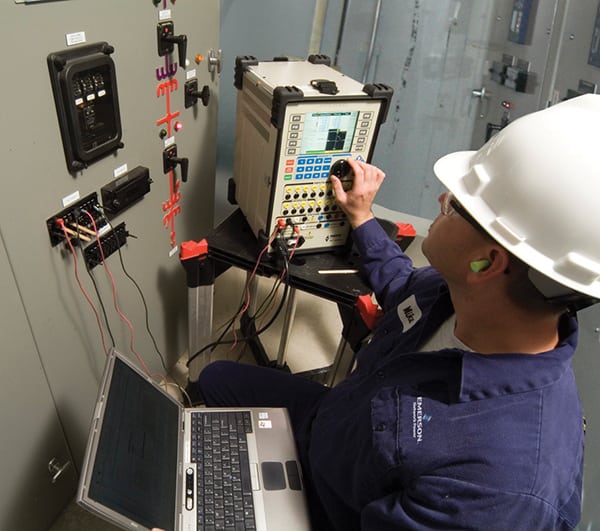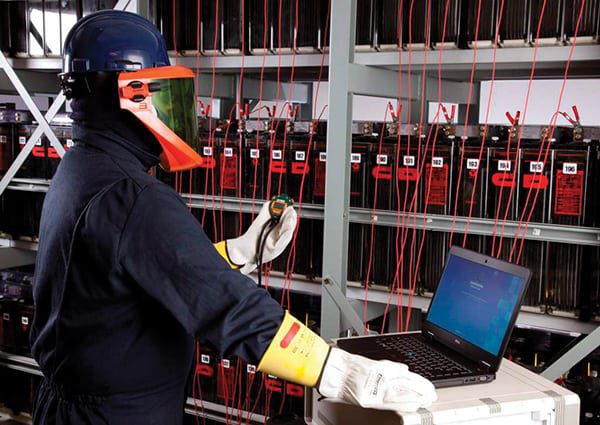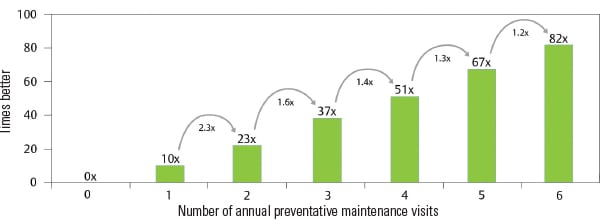Intelligent Monitoring of Distribution and Emergency Power Systems Improves Availability
Problematic power plant systems diminish availability and directly affect plant productivity and efficiency. In order to maintain availability, electrical testing and maintenance services are imperative. Two systems that service technicians often need to address are the power distribution system and the emergency power system.
For power distribution, customers can face many challenges related to relay maintenance and testing due to the use of multiple generations of relays all in one integrated protection scheme (Figure 1). But one way to overcome this challenge is to replace aging electromechanical relays with new-generation microprocessor-based relays or intelligent electronic devices (IEDs). This retrofit is fast and cost-effective, and can benefit plant owners and operators in a number of ways. However, upgrading to IEDs is only the first step toward realizing many benefits. Configuring proper logic is the next.
 |
| 1. Relay maintenance can be challenging. In some cases, testing is complicated as a result of multiple generations of relays being combined into one protection scheme. Courtesy: Emerson Network Power |
Most IEDs come pre-programmed with the manufacturer’s default settings and can provide a basic level of system protection. However, they are rarely ideal for meeting a facility’s specific protection requirements. Working with a qualified protection and/or integration engineer to appropriately configure IED settings and logic will maximize the following benefits afforded by a newly retrofitted system.
Easier Regulatory Reporting and Compliance
When condition and status monitoring, remote control capabilities, and other similar operations are integrated into the IEDs, these self-test features can be used to protect the entire electrical system. In addition to improving system reliability and increasing mean time between failures (MTBF), self-testing simplifies compliance with North American Electric Reliability Corp. (NERC) PRC-005 protection system maintenance program requirements for utilities.
NERC requires maintenance testing procedures, testing intervals, and documented test results. When a protection engineer approaches the design of the relay application with NERC requirements in mind, the self-test features of the IED can be leveraged to automatically satisfy many of these requirements.
For example, the IEDs can be programmed to continuously monitor the internal health of components, including DC circuits and trip coil circuits. They can also validate signal status, analog inputs, output circuits, and communication links. The relays can even monitor breaker wear, status of transformer auxiliaries, and ambient environmental conditions.
System designers can further simplify NERC compliance by configuring the IEDs to work in conjunction with a communication processor, reporting software, and supervisory control and data acquisition systems to automatically communicate results of the self-tests and generate documentation for NERC reporting.
Reduced Maintenance
NERC compliance primarily applies to utilities. But utilities and industrial facilities alike have a need to reduce maintenance time and costs. Maintenance concerns can influence the design of a relay application, and self-testing features can be used to alleviate some of these concerns.
A traditional system with multiple electromechanical switchboard components can be complicated and unreliable. Such a system requires diligent calibration, maintenance, and repair to keep it functioning. When discrete components are eliminated and their functions are programmed into an IED, there are fewer components to test and maintain. In addition, many inspection and testing procedures are performed automatically and continuously while the system is operating, reducing the need for manual testing procedures along with the scheduled downtime needed to perform the activities.
Properly functioning IEDs and power distribution systems aren’t the only concerns for power plant operators. A compromised emergency power system can mean trouble. Uninterruptible power supply (UPS) units and their batteries must function properly during emergencies like an unexpected plant trip. At this critical time, batteries supply power to digital control systems and emergency lube oil pumps to enable automatic controls to do their job and to provide lubrication to the generator, respectively. If the batteries don’t do their job, serious damage and personal injury could result. Damaged equipment could take months and cost millions to repair, while lost power production could be even more expensive and lead to fines and penalties. A proper maintenance program can help by yielding the following benefits.
Increased Battery Life
Every emergency power system contains life-limited components that should be maintained, according to the manufacturer’s specifications and as required by NERC, and batteries are no exception. In the event of a power outage, a single bad cell in a string of batteries could compromise the entire backup system and leave a plant without protection.
While UPS battery manufacturers may market their batteries with a 10-year design life or life span, the actual service life of the battery will be much shorter due to the external factors that cause degradation. The reality is that batteries lose capacity in as few as three years due to several factors, including usage, operating environment, and insufficient maintenance.
Because of the many factors that can affect the useful life of a UPS battery, it is important that—as soon as it is placed into service—a battery should be maintained with a program that identifies system anomalies and provides information that trends end of life (Figure 2). Through this type of maintenance program, plant owners and operators are able to get the most out of their investment in these critical assets.
 |
| 2. Tests will tell. The useful life of battery systems is dependent upon many factors. Regular testing can help plant owners determine when replacement is necessary. Courtesy: Emerson Network Power |
Batteries that are beginning to fail cause an imbalance that adversely affects the life of other batteries in the string and should be removed from service. And when a UPS battery needs to be replaced, time is of the essence, especially when considering the staggering financial impact that an extended or unplanned outage can have on an organization.
Maximized System Reliability
To avoid UPS battery failure that leads to downtime, the best practice is an approach that includes integrated battery monitoring and preventive maintenance (PM). In Emerson Network Power’s data analysis of more than 450 million operating hours for more than 24,000 strings of UPS batteries, the effect that regular PM had on reliability was clear. This analysis revealed that the MTBF for units that received two PM service visits a year is 23 times better than a UPS with no PM visits (Figure 3).
Furthermore, those with battery-monitoring systems installed at their site had a reduced rate of outages due to bad batteries. While outages did still occur, the incidents were isolated to cases where customers were either not watching their system or they did not know how to properly analyze the data provided by the monitor. This brought to light the need for experts to correctly monitor the alarm data and properly maintain the systems.
Improved System Availability
The use of stationary battery monitors with remote professional analyst services gives power plant operators a way to collect comprehensive battery data and receive early warning of alarm or out-of-tolerance conditions. Ultimately, using this combination improves MTBF and another measure of availability: mean time to repair. Power plants can move away from the common time-based maintenance cycles to a new service model where there is faster notification of an event, followed by the ability to have remote system engineers analyze data and diagnose the problem.
Not having a power distribution system or emergency power system working properly is problematic to many power plants and can have a detrimental effect on an organization. However, implementing the best practices in upgrade and maintenance services can help owners and operators realize many benefits, including simplified maintenance, easier regulatory compliance, improved safety, and better overall availability. ■
— Wally Vahlstrom is director of technical services for Emerson Network Power’s Electrical Reliability Services group.
